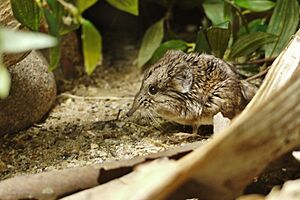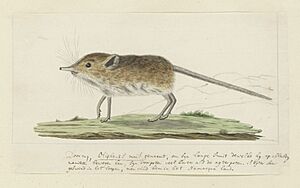Macroscelides proboscideus facts for kids
Quick facts for kids Macroscelides proboscideus |
|
|---|---|
 |
|
| Conservation status | |
| Scientific classification | |
| Genus: |
Macroscelides
|
| Species: |
proboscideus
|
 |
|
| Geographic range | |
The round-eared elephant shrew (Macroscelides proboscideus), also known as the round-eared sengi, is a small mammal. It belongs to the elephant shrew family, Macroscelididae. You can find this unique animal in parts of Botswana, Namibia, and South Africa.
These shrews live in dry areas like shrubland, grassland, and hot deserts. They mostly eat insects, but also munch on shoots and roots. A baby elephant shrew grows inside its mother for about 56 days before it is born.
Contents
Amazing Mates: How Elephant Shrews Live
Elephant shrews are special because they are one of the few mammals that are monogamous. This means a male and female pair stay together for a long time, often for life. Scientists study them to understand how animals form such strong pairs.
Protecting Their Partner
Male round-eared elephant shrews often show a behavior called "mate guarding." This means the male stays close to the female, especially before and after she can have babies. This helps to keep other males away. By doing this, the male makes sure he is the only one to mate with the female.
This guarding behavior makes the male very dedicated to his partner. However, it also means he spends a lot of time focused on her. This can make him more open to dangers in his surroundings.
How They See the World
Recent studies suggest that elephant shrews might see colors in a special way. They seem to have "dichromatic color vision." This means they can tell the difference between blue and green colors, as well as shades of grey. However, scientists have not found evidence that they can see red colors.
Where Round-Eared Elephant Shrews Live
The round-eared elephant shrew lives in Southeast Africa. The weather in their home changes with the seasons. In winter, temperatures can range from 6°C to 18°C. During the summer, it gets much warmer, from 22°C to 30°C.
What They Eat: Foraging and Diet
Round-eared elephant shrews are omnivores, meaning they eat both plants and animals. Their main food source is insects. They also eat parts of plants, like shoots and roots.
Seasonal Eating Habits
The amount of insects they eat changes with the seasons. In winter, there are fewer insects around. Because of this, the shrews eat less insects during the colder months. They likely rely more on plant parts during this time.
Reproduction and Life Cycle
Round-eared elephant shrews have a specific breeding season. They do not reproduce during the winter months. This is likely because food, especially insects, is harder to find during the colder season.



